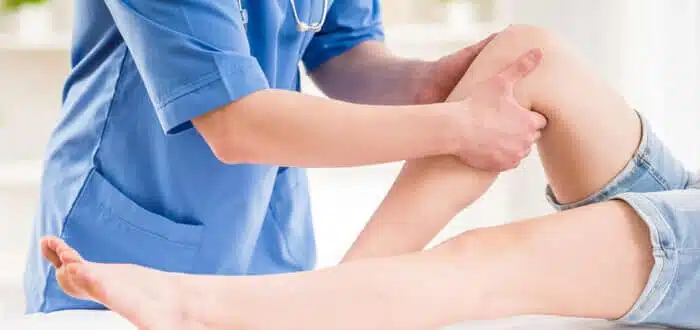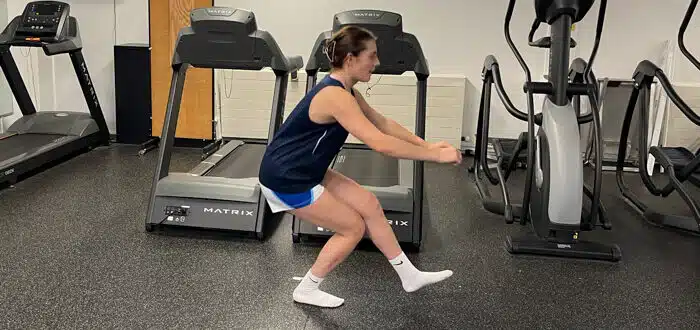
Worn out knee? 5 tips against knee osteoarthritis (wear and tear)
What is knee osteoarthritis?
Worn-out knee, wear and tear or osteoarthritis. All terms for the same thing, but what is osteoarthritis? Wear or osteoarthritis is a condition of the joint. Primarily in osteoarthritis, the quality of cartilage deteriorates. This is a progressive process in which the development of osteoarthritis varies from individual to individual. Cartilage becomes thinner, softer and friable. This can also cause the quality of the underlying bone to deteriorate. Due to pain, swelling and less movement, the quality of the muscles, tendons around the knee decreases. Periodically, the knee joint can become inflamed. All in all, it is a tedious process in which the entire knee is affected. The risk of osteoarthritis increases with age. Certainly over the age of 45, it is more common with a peak around age 79. In the Netherlands, 1.5 million people have osteoarthritis. Osteoarthritis is relatively most common in the knee joint. In 2015, there were about 550 thousand people in the Netherlands with knee osteoarthritis.
With knee osteoarthritis, you often experience pain, difficulty with intense movement and onset or morning stiffness. Pain often occurs when starting to move and with prolonged loading. Pain often increases as the day progresses. In more advanced stages, pain may also occur at rest or at night. An inflammatory process may occur causing the knee to become thick and warm. Muscles around the joint may weaken and tendons become irritated, sometimes experiencing instability as a result. Osteoarthritis in this way interferes with sports, work and daily life.
The degree of symptoms does not equal the amount of wear and tear on an X-ray. People with extensive wear of the knee joint can sometimes report surprisingly few symptoms and vice versa. Knee wear is a continuous process and cannot recover. Yet you can intelligently influence the process.
I suffer from a worn-out knee, what can I still do?
is one of the many questions clients ask. Other questions include:
- Does my knee wear out harder by moving?
- Can I continue to play sports with a worn-out knee?
- Is sitting still good for the knee?
- Should I change my diet?
- Does body weight play a role?
- What can I do about knee pain?
In this blog, we provide tips on how to deal with osteoarthritis and answer the most common questions. If you want to know more about osteoarthritis click here.
5 tips against knee osteoarthritis:
Tip 1: Does moving wear my knee harder?
A: Keep moving with a worn-out knee. Cartilage does not wear down harder with exercise. In fact, cartilage must be loaded to stay healthy. Movement lubricates and nourishes cartilage. In addition, moving keeps the muscles and tendons around the joint healthy. Strong muscles are needed to absorb the forces on the knee, so the knee is less likely to be overloaded. Keeping moving also improves overall fitness. You need this to keep your body healthy. It is important to explore your own limits, but half an hour a day of cycling, swimming or walking is a good first step. Supplement this with muscle-strengthening exercises twice a week. Also look at the Dutch Standard for Healthy Exercise. Indeed, being passive and sitting still all day can make osteoarthritis symptoms worse. It also increases the risk of other conditions such as diabetes and cardiovascular disease.
Tip 2: Can I keep exercising and stay physically active?
Antwoord: blijf bewegen, maar verdeel je activiteiten.
A: Keep moving with a worn-out knee. Cartilage does not wear down harder with exercise. In fact, cartilage must be loaded to stay healthy. Movement lubricates and nourishes cartilage. In addition, moving keeps the muscles and tendons around the joint healthy. Strong muscles are needed to absorb the forces on the knee, so the knee is less likely to be overloaded. Keeping moving also improves overall fitness. You need this to keep your body healthy. It is important to explore your own limits, but half an hour a day of cycling, swimming or walking is a good first step. Supplement this with muscle-strengthening exercises twice a week. Also look at the Dutch Standard for Healthy Exercise. Indeed, being passive and sitting still all day can make osteoarthritis symptoms worse. It also increases the risk of other conditions such as diabetes and cardiovascular disease.
Tip 3: Is sitting still good for a worn-out knee?
A: look at alternative forms of exercise.
In the case of knee problems try to reduce peak stress. High pressure on the knee occurs especially when running and jumping. Alternatively, cyclic exercise is better. Cycling and swimming are ideally suited for people with knee osteoarthritis. If you would still like to continue your current sports, try to adjust the load first. The factors you can influence yourself are the duration, frequency and intensity of the load. For example tennis go doubles instead of single play. Go from playing tennis three times a week to playing tennis twice a week. Alternatively, you can replace the third tennis workout by cycling. In running, you can adjust the distance and duration and frequency per week.
If exercise is no longer possible look at other alternatives such as: Tai chi, research shows that this type of exercise can give reduction of complaints, fitness, cycling and swimming. If the symptoms persist, the physical therapist can provide specific exercises to improve strength, stability and coordination.
Tip 4: Should I adjust my diet?
A: maintain a healthy body weight. Especially with the knee, body weight clearly affects the onset and development of osteoarthritis. Every kilo too much is extra strain on the knee joint. To prevent strain, achieving a healthy body weight is important. The nutrition center uses a BMI of 18.5-25 as a healthy weight for people aged 19 to 69 and a BMI of 22-28 for those 70 and older. If this requires losing weight, lots of exercise is obvious. But (excessive) exercise also causes overexertion. Exercise enough but pay particular attention to nutrition. Losing weight through diet is most effictive. Experts indicate that a balanced diet can reduce the symptoms of osteoarthritis. This includes making sure you get enough Omega 3 fatty acids to reduce inflammation and Vitamin C to maintain healthy cartilage. Consider adequate fruits, vegetables and fatty seafood (herring, mackerel and salmon). Seek advice from a dietician for a balanced diet.
Tip 5: What can I do about knee pain?
A: You can reduce pain in several ways. The symptom pain and stiffness are at the forefront for many people with knee osteoarthritis. These cause most limitations in daily life. A healthy and measured lifestyle is one of the most important tips. Do the above tips not help enough?
There are a number of other ways to influence pain. Note that these are often not structural but temporary solutions.
- Cold compresses: in cases of joint inflammation, cooling can be pain-relieving.
- Warm compresses: for a stiff joint, a source of heat can make movement smoother.
- Medication: if you do not get the pain under sufficient control, paracetamol is a good option. If this does not work sufficiently, consult your doctor. He or she may prescribe anti-inflammatory painkillers or consider an injection of corticosteroids.
- Weather conditions: it seems that warm weather causes fewer symptoms of pain and cold weather causes more symptoms of pain. This may be a reason people have fewer symptoms on vacation.
- Alternative treatment method: consider acupuncture or nutritional supplements such as glucosamine. More research should be done on the effect.
- Change your posture frequently. Try to alternate sitting still and standing. Make several knee bends and stretch and flex the knee regularly.
Tailoring your lifestyle to osteoarthritis has great benefits. For example, it reduces symptoms, slows the development of osteoarthritis, helps keep you healthy and may prevent joint replacement surgery.

